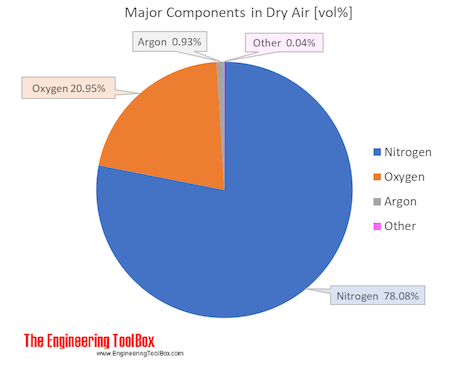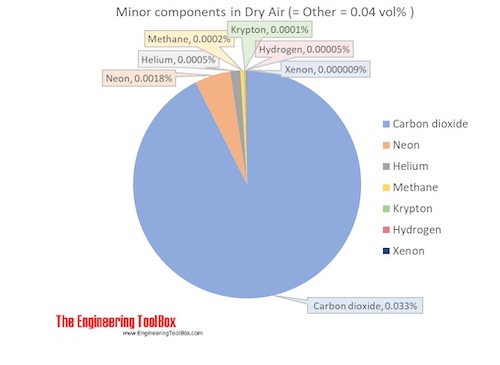Air At Altitude Same Percentage Makeup Of Elements?
Components in Dry out Air
Air is a mixture of several gases, where the 2 most ascendant components in dry air are 21 vol% oxygen and 78 vol% nitrogen. Oxygen has a molar mass of xv.9994 g/mol and nitrogen has a tooth mass of 14.0067 one thousand/mol. Since both of these elements are diatomic in air - O2 and N2 , the tooth mass of oxygen gas is 32 one thousand/mol and the tooth mass of nitrogen gas is 28 chiliad/mol.
The boilerplate molar mass is equal to the sum of the mole fractions of each gas multiplied by the tooth mass of that particular gas:
Thousandmixture = (101*M1 + ......+ xn*Mnorth) (ane)
where
xi = mole fractions of each gas
Mi = the molar mass of each gas
The molar mass of dry air is 28.9647 g/mol. Composition and content of each gas in air is given in the figures and the table beneath.


See also Air Density at varying pressure, Density and specific weight at varying temperature, Diffusion Coefficients for Gases in Air, Dynamic (absolute) and kinematic viscosity, Prandtl Number, Specific heat at varying temperature and Specific heat at varying pressure, Thermal Conductivity, Thermal Diffusivity, Backdrop at gas-liquid equilibrium conditions and Air properties, for other properties of air
Air is usually modeled as a compatible (no variation or fluctuation) gas with properties averaged from the private components.
For total table - rotate the screen!
| Components in dry air | Book ratio = Molar ratio compared to dry air | Molar mass | Tooth mass in air | Atmospheric boiling point | |||||
| Proper name | Formula | [mol/molair] | [vol%] | [g/mol], [kg/kmol] | [g/molair], [kg/kmolair] | [wt%] | [K] | [°C] | [°F] |
| Nitrogen | N2 | 0.78084 | 78.084 | 28.013 | 21.872266 | 75.511 | 77.4 | -195.viii | -320.4 |
| Oxygen | Otwo | 0.20946 | twenty.946 | 31.999 | 6.701942 | 23.14 | 90.ii | -183.0 | -297.three |
| Argon | Ar | 0.00934 | 0.934 | 39.948 | 0.373025 | i.29 | 87.3 | -185.8 | -302.v |
| Carbon dioxide1) | CO2 | 0.000412 | 0.0412 | 44.010 | 0.018132 | 0.063 | 194.seven | -78.five | -109.ii |
| Neon | Ne | 0.00001818 | 0.001818 | twenty.180 | 0.000367 | 0.0013 | 27.2 | -246.0 | -410.7 |
| Helium | He | 0.00000524 | 0.000524 | 4.003 | 0.000021 | 0.00007 | 4.two | -269.0 | -452.1 |
| Methyl hydride | CHiv | 0.00000179 | 0.000179 | sixteen.042 | 0.000029 | 0.00010 | 111.seven | -161.five | -258.7 |
| Krypton | Kr | 0.0000010 | 0.0001 | 83.798 | 0.000084 | 0.00029 | 119.viii | -153.four | -244.0 |
| Hydrogen | H2 | 0.0000005 | 0.00005 | 2.016 | 0.000001 | 0.000003 | 20.3 | -252.9 | -423.ane |
| Xenon | Xe | 0.00000009 | 0.000009 | 131.293 | 0.000012 | 0.00004 | 165.ane | -108.i | -162.five |
| Boilerplate molar mass of air | 28.9647 | ||||||||
1) A ccording NASA CO2 level in 1960 aprox. 320 ppm, 1970 aprox. 328 ppm, 1980 aprox. 341 ppm, 1990 aprox. 356 ppm, 2000 aprox. 372 ppm, 2010 aprox. 390 ppm and 2020 aprox. 412 ppm
Back to tiptop
- The water or vapor content in air varies. The maximum wet carrying chapters of air depends primarily on temperature
- The composition of air is unchanged until elevation of approximately 10.000 m
- The average air temperature diminishes at the rate of 0.6oC for each 100 m vertical height
- "One Standard Atmosphere" is defined equally the force per unit area equivalent to that exerted by a 760 mm column of mercury at 0oC sea level and at standard gravity (32.174 ft/sectwo )
Other components in air
- Sulfur dioxide - SOii - 1.0 parts/million (ppm)
- Nitrous oxide - NtwoO - 0.5 parts/million (ppm)
- Ozone - O3 - 0 to 0.07 parts/million (ppm)
- Nitrogen dioxide - NO2 - 0.02 parts/one thousand thousand (ppm)
- Iodine - Iii - 0.01 parts/million (ppm)
- Carbon monoxide - CO - 0 to trace (ppm)
- Ammonia - NHiii - 0 to trace (ppm)
Common Pressure level Units oft used every bit alternative to "one Atmosphere"
- 76 Centimeters (760 mm) of Mercury
- 29.921 Inches of Mercury
- ten.332 Meters of Water
- 406.78 Inches of Water
- 33.899 Anxiety of Water
- 14.696 Pound-Force per Foursquare Inch
- 2116.ii Pounds-Force per Square Foot
- 1.033 Kilograms-Force per Square Centimeter
- 101.33 kiloPascal
Come across also Air Density at varying pressure, Density and specific weight at varying temperature, Improvidence Coefficients for Gases in Air, Dynamic (absolute) and kinematic viscosity, Prandtl Number, Specific oestrus at varying temperature and Specific rut at varying pressure level, Thermal Conductivity, Thermal Diffusivity, Properties at gas-liquid equilibrium conditions and Air properties, for other backdrop of air
Source: https://www.engineeringtoolbox.com/air-composition-d_212.html
Posted by: leewheink.blogspot.com

0 Response to "Air At Altitude Same Percentage Makeup Of Elements?"
Post a Comment